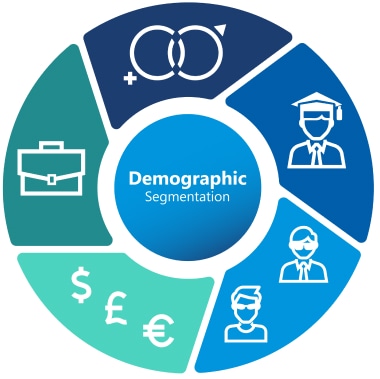Results for “”

Demographic segmentation is target market demographic data collected from prospective clients that can be used to segment markets primarily based on age, gender and income.
Demographic data is based on multiple static variables that serve as indicators for marketing and sales decisions:


Age can serve to inform the appropriate messaging for various target groups. Depending on their age, prospective clients may respond differently to things like the tone of voice, style, and channels of communication.
One demographic segmentation example is the categorization of leads by their generation, such as Baby Boomers (typically people born between 1946-1964), Millennials (1980-1995), or Generation Z (1996-2010).
It might be that certain trends can be gleaned from the shared experiences of a certain generation, which in turn may influence commonly held ideas or practices that can inform marketing strategies.
However, whilst a timesaving and easily identifiable way of categorizing people, don’t assume generational profiling will provide all the necessary detail to ensure campaigns are targeted successfully and received positively.
Instead, use age-based demographic data as a starting point and progress from there.
Identifying the income of prospects can help qualify them in terms of buyer intent. It can also inform the subsequent pricing of products and services, or even whether the market is worth investing in at all.
This aspect of demographic segmentation allows for the identification of high-value prospects to help marketers prioritize resources, time, and effort.
Although education level in the traditional sense may not appear to be particularly important in the world of B2B marketing, determining a prospect’s knowledge on a specific subject matter can be useful, particularly if they hold any additional business qualifications (for example, a Master’s degree in project management).
Knowledge of certifications can help to guide outbound marketing efforts by addressing topics and problems that prospects are familiar with. This also assists lead nurturing in the sense that marketers can avoid distributing irrelevant educational material to those contacts who are already well informed.
The importance of identifying gender and marital status as part of the demographic market segmentation process is dwindling in the modern age as traditional gender roles, even gender itself, becomes more fluid.
As such, formulating strategies based on these variables is no longer as effective as it once was. However, combined with additional supporting data, gender and marital status still have the potential to aid outbound marketing and the personalization of campaigns.
Determining the job titles and occupations of potential clients can prove to be instrumental in identifying prospects who have the most decision-making power, and therefore purchasing authority.
Knowledge of what your contacts do for a living can also help to tailor messaging and further personalize campaigns, or to create products that may have a unique appeal or utilization to certain types of professionals.
Market segmentation within B2B marketing refers to the process of identifying and sorting key groups of potential clients within a broad target market.
It can be achieved by utilizing multiple market segmentation methods including demographic, psychographic, behavioral, firmographic, and geographic segmentation. Data collected during this process allows marketers to develop distinct sub-categories within their potential client database.
This information is used to better guide sales, align marketing strategies and personalize campaigns in the way that buyers have come to demand.
Below are some demographic segmentation examples and best practices for utilizing this data.
To optimize both marketing and sales content and for companies to avoid wasting budgets on ineffective materials, developing the right messaging is key.
Data from demographic segmentation can be leveraged to draw correlations and conclusions about what messaging prospects will respond best to, and then to personalize campaigns to fit.
As markets continue to become more crowded and prospects continue to become better informed, this personalization is crucial. Clients are searching for businesses that understand them, their needs, and how to solve current problems or prevent them from occurring in the future.
Demographic segmentation data concerning income, revenue, and pricing can inform multiple business decisions.
Once key target market data has been identified and verified it can be leveraged to create the right pricing for the various products and services that are going to be marketed to those groups.
Pricing should be optimized for profitability. Ideally, by reflecting the average income and spending power of each potential client, together with the innate value of the solution provided and costs incurred.
Different pricing strategies can be developed to encourage leads to make a purchase. Often this involves special offers, discounts, or flexible payment plans to drive positive conversions in the final stages of the sales funnel.
Insights gained from income data and pricing guided by demographic segmentation can help companies avoid marketing products that are too expensive, too cheap, that don’t reflect the true value, or that are simply not the right fit for potential clients.
Demographic segmentation is one of many tools that marketers have at their disposal for filtering leads into distinct groups and revealing new, often specific target markets that are within a broader un-segmented market.
These new markets are either new in the sense that they have not been marketed to by the company in question, or that they are yet untapped as their unique needs have so far failed to have either been identified or met by competitors.
Either scenario generally represents an enormous potential for increasing a company’s reach and revenue. Demographic market segmentation data can help companies decide if the investment is worth the reward.
While demographic segmentation is often the easiest and cheapest marketing segmentation method, it is important not to overestimate its value or to rely solely upon the information it can provide.
All well-designed marketing and sales strategies should incorporate data from multiple sources in order to build the most accurate profiles of the target market, or of individuals within those markets (buyer profiles).
Essentially, any insights gathered from demographic segmentation should not be taken at face value. Indeed, recognizing the limitations of demographics is essential for maximizing the utility of demographic data in developing strategies.
Although job titles and occupations can be identified by demographic segmentation it is important to take into consideration the wide-ranging or changing nature of B2B roles. There are often inconsistencies with the titles given to some jobs, or they may simply fail to represent the actual responsibilities of the position they describe. As such, conclusions drawn from job titles alone may be unreliable.
Demographic segmentation is excellent as a first step at dividing broad markets into smaller groups. However, campaigns informed by demographics alone tend to suffer as groupings are based on the principle that all prospects want or need the same solutions.
Potential clients can have complex, multiple, maybe even conflicting needs which require a detailed understanding. As such, strategies guided by just one segmentation marketing method, such as demographics, can result in fundamental pain points being overlooked.
As stated, demographic market segmentation can provide insights that are vital to ensuring sales and marketing campaigns have been crafted in a way to best appeal to specific target segments.
However, to get the most out of this method it is beneficial to combine it with a variety of other types of market segmentation strategies like those outlined in the introduction.
Whilst demographic segmentation examples typically focus on the individual, firmographics, for instance, can supply information about entire companies, or the markets in which they operate.
Utilizing additional target market segmentation strategies such as psychographics and behavioral segmentation in marketing campaigns can guide the implementation of more detailed and personalized materials that really hit home with prospects.
Having identified your leads, insights from psychographic and behavioral market segmentation can be used to connect with them on a deeper cognitive or personal level.
Understanding people’s personalities is important. It will help teams create more accurate buyer personas and tailor personalization more precisely.
Demographic segmentation is a good starting point when it comes to devising your next marketing or sales strategy.
It is one of the most efficient ways for companies to divide broad target markets into manageable groups in a low-cost and timely manner.
However, much like any other strategy, collecting demographic data is a continuous process that is not reliable without accurate interpretation and supporting information.
When combined, target market segmentation strategies are an incredibly useful tool that can work to optimize marketing and sales campaigns by ensuring they understand and communicate to target audiences in the desired way.
To provide the best experiences, we use technologies like cookies to store and/or access device information. Consenting to these technologies will allow us to process data such as browsing behavior or unique IDs on this site. Not consenting or withdrawing consent, may adversely affect certain features and functions.